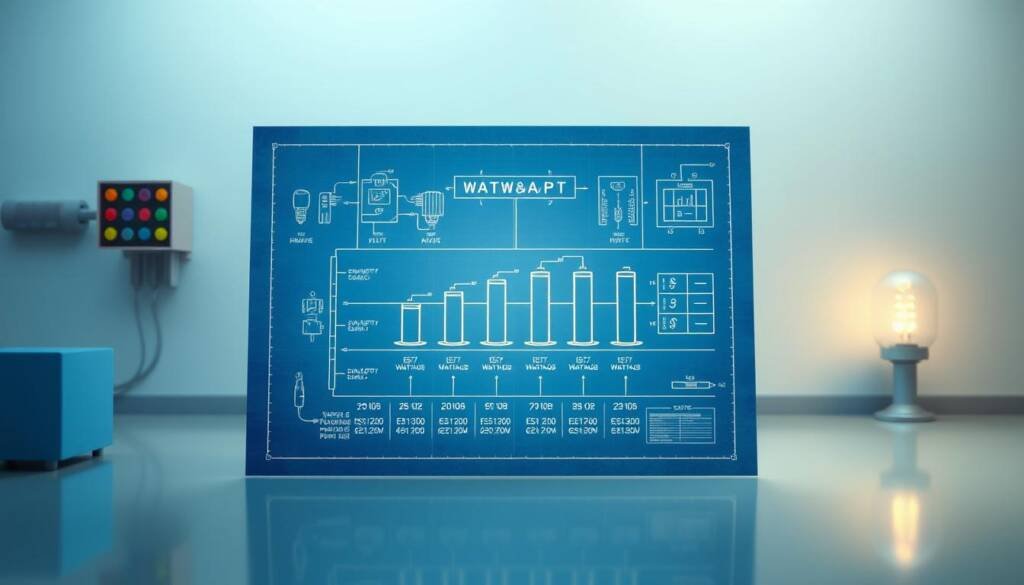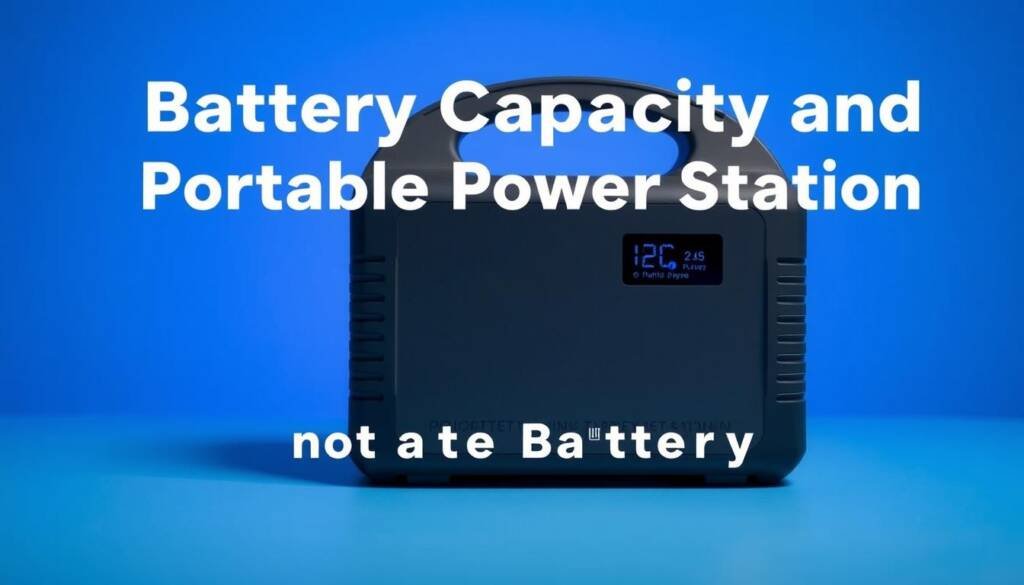Are you tired of being left in the dark during power outages? Or do you struggle to keep your devices charged while camping? A portable battery power station might be the answer you’ve been searching for. But with so many options available, how do you pick the right one for you?
Portable battery power stations, also known as solar generators or lithium-ion battery packs, are great for off-grid situations. They’re perfect for camping trips, emergency prep, or remote work. These power solutions come in various sizes and capacities to fit your needs.
When choosing a portable battery power station, think about your power needs. Consider what devices you’ll be using, like smartphones, laptops, or small appliances. Make sure to calculate the total wattage needed to find a power station with enough capacity and output.
Battery capacity is key, as it tells you how long your devices can run without needing a recharge. Power stations range from 200Wh to over 2,000Wh. But remember, bigger capacity means heavier and less portable.
Key Takeaways
- Assess your power needs by considering the devices you’ll be running and their wattage requirements.
- Choose a portable battery power station with sufficient capacity and output to meet your needs.
- Consider factors like size, portability, inverter type, input and output options, and brand reputation when making your decision.
- Look for features like pure sine wave inverters, multiple charging options, and reliable customer support.
- Invest in a portable battery power station that aligns with your specific use case, whether it’s camping, emergency backup, or remote work.
Understanding Portable Battery Power Stations

Portable battery power stations are now a top choice for backup power in many situations. They are big, rechargeable batteries with AC outlets, USB ports, and more. This makes them great for charging electronics and small appliances when you’re not near a power outlet.
These devices are quiet and don’t pollute, perfect for outdoor power sources like camping or tailgating. They’re also key for emergency prep, offering power when disasters like hurricanes or wildfires knock out the grid.
What is a Portable Battery Power Station?
A portable battery power station is a big, rechargeable battery with many output ports. This lets you charge lots of devices at once. Models like the BLUETTI AC200MAX have 4096Wh capacity and 2200W output. Others, like the BLUETTI AC300, have 3072Wh capacity and 3000W output.
Benefits of Owning a Portable Battery Power Station
Having a portable battery power station brings many advantages, including:
- They’re quiet and don’t pollute, making them safe for indoor and outdoor use.
- They offer many charging options, like AC outlets, 12V vehicle chargers, and solar panels.
- They can charge many devices at once, with some models having up to 20 charging ports.
- They’re built to last and are easy to carry, even in tough outdoor conditions.
- They provide reliable backup power during emergencies or when the power goes out.
Determining Your Power Needs

When picking the right portable battery power station, start by figuring out your power needs. First, list the devices you want to power. Then, add up their total wattage.
Start by making a list of devices you’ll power with the station. This includes phones, laptops, LED lights, and small appliances. For example, a smartphone uses about 20 watt-hours, and a bright LED light uses 30 watts.
Assessing the Devices You Need to Power
After your list is ready, look up each device’s wattage. You can find this info on the device or in its manual. Remember, some devices have different wattage ratings for normal use and peak use.
Calculating Total Wattage Requirements
To find your total wattage needs, multiply each device’s wattage by how long you’ll use it. For instance, if you’re charging 20 smartphones, it’s 20 watt-hours x 20 = 400 watt-hours. Don’t forget to add 10% for efficiency losses, making it 440 watt-hours.
It’s wise to add 25% more to your estimate to make the battery last longer. For the smartphone example, you’d need a station with at least 550 watt-hours (440 + 25%).
By understanding your devices and their wattage, you can pick the right portable battery power station. This ensures it meets your power needs.
Battery Capacity and Run Time

When picking a portable battery power station, battery capacity is key. It’s measured in watt-hours (Wh). This tells you how long your devices can run on one charge. A higher capacity means longer run times, keeping your devices powered when you need them.
To figure out how long your devices will run, divide the power station’s capacity by the total wattage of your devices. For instance, a 1000Wh power station can power a 100W device for 10 hours. But, actual times can change due to battery age, temperature, and device efficiency.
Many portable power stations let you add more battery storage. This means you can increase capacity and run time as your needs grow. This is great for long camping trips or power outages.
Look at the power station’s output, including peak and continuous wattage. Peak output is important for devices needing a lot of power at first, like refrigerators. Also, make sure it has a pure sine-wave output for safe use with sensitive electronics.
“Investing in a portable power station with a high battery capacity and efficient power output can provide peace of mind and reliable energy management in various situations, from outdoor adventures to emergency backup power.”
Here are some examples to show how battery capacity affects run time:
- A 40,000mAh (480Wh) battery at 12V can power a 90W device for about 5 hours
- A 100,000mAh (1200Wh) battery at 12V can power a 100W device for roughly 12 hours
By choosing a power station with the right battery capacity and output, your devices will stay powered. This is true for camping, working remotely, or during power outages. Remember to consider watt-hours, run time, and amp-hours when picking the best portable power solution for you.
Portable power stations with high capacity and efficient output are flexible and reliable. They’re great for managing energy in outdoor adventures and emergency situations.
How to Choose a Portable Battery Power Station
Choosing the right portable battery power station can be tough. There are many options out there. To make a good choice, think about a few key things. This will help you find the best power station for your needs.
Size and Portability Considerations
Size and weight are important when picking a portable battery power station. If you’ll be using it for camping or outdoor trips, choose something small and light. These power stations can be as big as a microwave or as small as a brick. They usually weigh between 80-100 pounds, depending on their size and features.
Inverter Type: Pure Sine Wave vs Modified Sine Wave
The type of inverter is a big deal when choosing a power station. Pure sine wave inverters give a smooth power that’s good for things like laptops and phones. Modified sine wave inverters are cheaper but might not work with all devices. They can cause problems like buzzing sounds or lower efficiency in some appliances.
Input and Output Options
When it comes to input and output options, versatility is key. Look for power stations with lots of charging ports, like AC outlets, DC ports, and USB ports. This lets you charge many devices at once. Also, think about power stations that can charge from the sun, wall outlets, and car chargers. This makes them more flexible and convenient.
Brand Reputation and Customer Support
Buying from a well-known brand means you get quality and reliable service. Brands like Jackery, EcoFlow, Bluetti, and Anker are leaders in the field. They offer great products and excellent customer support. These companies usually have good warranties, detailed manuals, and help when you need it.
Top Portable Battery Power Station Brands
Looking for the best portable power stations? It’s key to pick reliable brands that fit your needs and budget. We’ll look at the top brands and compare their products to help you choose wisely.
Jackery
Jackery is a big name in portable power stations. They offer compact and light options. The Jackery Solar Generator Kit 4000 has 4085.6Wh capacity and 3000 watts power. It’s light at 61.5 pounds and has 10 ports for easy connection.
EcoFlow
EcoFlow is known for powerful and feature-rich stations. The EcoFlow Delta Max 2 has 6144Wh capacity and 15 outputs. The EcoFlow Delta 2 Max has 2048Wh capacity and lasts 3000 cycles to 80% capacity. These are great for those needing lots of power.
Bluetti
Bluetti has a range for all needs and budgets. The Bluetti AC70 has 768Wh capacity and weighs 22.5 lbs. It’s perfect for those who want something light. The Bluetti AC240 has 1,536Wh capacity and 2400 watts power, ideal for heavy use.
Anker
Anker is a trusted name in electronics, including portable power stations. The Anker PowerHouse 767 has 2048Wh capacity and lasts 3000 cycles. The Anker Solix F3800 has 3840Wh capacity for extended power needs.
When comparing these brands, think about battery capacity, power, weight, and price. Whether you need something small for camping or a big solution for emergencies, these brands have what you need.
Charging Your Portable Battery Power Station
There are several ways to charge your portable battery power station. You can use an AC wall outlet, solar panels, or a car charger. Each method has its own benefits and things to consider. This lets you pick the best way to charge your power station based on your needs.
AC Wall Charging
Charging your power station with an AC wall outlet is easy and fast. AC outlets give more power than other methods, so charging is quicker. Just plug it into a wall outlet, and it starts charging. The time it takes to charge depends on the power station’s size, but AC charging is usually the fastest.
Solar Panel Charging
Charging with solar panels is green and handy, perfect for being off-grid. Connect your solar panels to the power station to use the sun’s energy. But, solar charging takes longer than AC charging. It depends on how much sunlight you get and the solar panels’ efficiency. Make sure your power station works with the solar panels and you have the right cables.
Car Charging
Car charging lets you recharge your power station while driving. Most power stations can use a car’s 12V DC outlet. It’s slower than AC charging but handy for travel. Always charge with your car running to avoid draining your car’s battery. The charging time can vary based on your power station’s size and your car’s charging port.
It’s important to follow the maker’s charging instructions and use the right cables. Don’t let your power station run out completely before charging. Also, keep it in a cool, dry spot, away from sunlight and moisture. Knowing how to charge your power station helps keep it ready to use anytime, anywhere.
Maintaining and Caring for Your Portable Battery Power Station
To keep your portable battery power station working well for years, follow some key steps. These steps will help extend its life and keep it running smoothly.
Storing your power station correctly is very important. Keep it in a cool, dry spot. Charge it between 50-80% when not in use. This helps avoid damage from overcharging or deep discharge.
Extreme temperatures can harm your power station. High heat can cut battery efficiency by 30%. Cold can drop it by 50%. Try to avoid using it in very hot or cold places.
Charging your power station right is also key. Always use the charger the maker suggests. The wrong charger can cause overheating and shorten battery life by 40%. Know your power station’s specs and don’t overload it to avoid problems.
Check your power station often for damage or wear. Clean the ports and vents to stop dust buildup. If you see any issues, like less battery life or odd charging, contact the maker for help.
By taking these easy steps, you can make sure your portable battery power station stays reliable. It will keep giving you power when you need it most.
Portable Battery Power Stations for Specific Uses
Portable battery power stations are great for many outdoor needs. They help with emergency prep and off-grid living. Whether camping, facing power outages, or working remotely, they provide reliable power.
Camping and Outdoor Adventures
For those who love the outdoors, these power stations are a must-have. They can power mini fridges for almost a day. This keeps your food fresh during your trip.
They also charge phones and run small appliances. This makes your outdoor adventures more comfortable.
Emergency Backup Power
When power goes out, these stations offer peace of mind. They can run a fridge for 12 to 38 hours. This keeps your food from spoiling.
They have many USB ports. This means you can charge your devices during emergencies.
Remote Work and Off-Grid Living
For remote workers or off-grid dwellers, these stations are perfect. The EcoFlow Delta Pro can power a whole kitchen. It’s great for laptops and routers too.
The Zendure SuperBase V6400 has 6,438 watt-hours. It can be expanded to 64,000 watt-hours. This means you can work or live off-grid without worry.
Conclusion
Choosing the right portable battery power station is key for reliable off-grid energy. It’s important whether you’re camping, working from anywhere, or getting ready for emergencies. Look at your power needs, how portable it is, and what features it has.
Brands like Jackery, EcoFlow, Bluetti, and Anker have many options. They offer capacities from 240Wh to 2,000Wh and outputs from 100W to 1,200W. These can power your phone, laptop, and small appliances.
When picking a power station, figure out your total wattage needs. Add 10-25% more for efficiency losses. This ensures your battery lasts longer. Look for models with AC, solar, and car charging options for flexibility.
Portability is also important. For example, the Jackery Explorer 240 v2 weighs only 6 lbs. It’s perfect for outdoor trips. Safety features like short-circuit protection and temperature control are vital. They prevent overheating and ensure the power station works well.
Investing in a top-notch portable battery power station gives you a clean, quiet, and eco-friendly power source. It’s great for power outages, off-grid adventures, and remote work. With the right power station, you’ll have peace of mind knowing you have a reliable energy solution for your needs.